Table of contents
AI for software testing: Benefits, use cases, and 5 amazing tools
//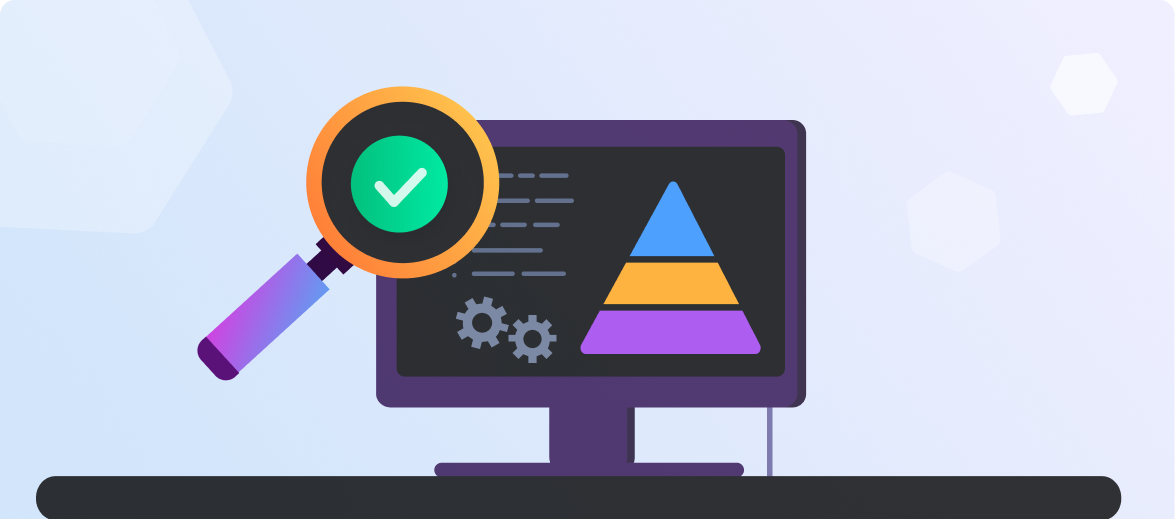
How is AI used for software testing?
AI technologies, in particular coding assistants based on large language models (LLMs), are revolutionizing software testing by introducing automation to a range of new tasks, including generating scripts, creating unit tests, and writing human-readable code explanations.
By automating the generation of test scripts, AI minimizes the manual effort required in scripting and maintaining them. This is especially beneficial in adapting to changes within the application under test, ensuring that the scripts remain relevant and accurate over time. AI can help generate unit tests, automating the validation of individual units of source code and reducing the burden on developers and testers. AI can also enhance knowledge sharing through automated code explanations and documentation.
Manual software testing vs. AI software testing
In traditional software testing, activities such as writing unit tests and maintaining them across different versions of the software require significant manual effort and are prone to human error. AI testing tools introduce automation to these processes, replacing the monotonous and error-prone aspects of manual testing.
Through AI, unit tests can be generated and updated automatically, reflecting changes in the software without the need for manual intervention. This not only speeds up the testing process but also enhances the accuracy and reliability of the tests.
Furthermore, AI-driven testing tools are equipped to handle test maintenance efficiently, updating tests to align with new features or changes in the software. This capacity for automatic adjustment reduces the burden on testers and developers, improves test coverage and ultimately improves software quality with the same testing resources.
4 advantages of AI in software testing
Using AI-enabled tools to test software offers the following benefits:
- Saving time for developers and testers: AI can automate many routine tasks carried out by developers and testers, allowing them to focus on more creative and strategic activities.
- Improved test coverage: AI in software testing extends test coverage by automating the creation of test cases across a wide array of scenarios. This enables more comprehensive coverage.
- Easier test maintenance: Updating tests for new releases can be tedious and place a huge burden on developers and testers. AI can efficiently and accurately update or “heal” tests to reflect new functionality.
- Supporting fast DevOps cycles: AI testing aligns with DevOps practices by facilitating continuous testing within the CI/CD pipeline. AI technology can help automatically create tests for each build, enabling immediate feedback on the impact of changes.
Use cases for AI in software testing
There are several ways that AI can be used to test software.
Automated script generation
AI tools can create test scripts from requirements documentation, user stories, or application interfaces. This process reduces the manual effort involved in writing and maintaining test scripts, enabling testers to focus on more complex tasks. Automated scripts are adaptable, updating as applications evolve.
Generate unit tests
Unit tests validate the smallest parts of an application’s codebase. This ensures each component functions correctly in isolation, facilitating early detection of defects. AI-driven unit test generation analyzes the source code to create relevant test cases, optimizing test coverage and efficiency. This can reduce the huge manual effort most development teams spend on writing unit tests.
Automated test execution
AI can be used to run predefined, dynamically generated test cases across different environments and configurations. This automation speeds up the testing process, allowing more extensive testing within shorter periods. AI algorithms optimize test sequences, predict outcomes, and adapt strategies based on results, enhancing test effectiveness.
Self-healing capabilities
Self-healing in AI testing refers to the automatic adjustment of test scripts when application changes occur. AI algorithms detect UI or API modifications and update test cases accordingly, reducing maintenance and ensuring tests remain relevant. This capability minimizes testing disruptions, providing consistent feedback despite ongoing development changes.
Code explanation and documentation
AI-driven code explanation and documentation tools automate the creation of technical documentation and code comments. This ensures code is easily understandable, facilitating maintenance and updates. Automation of these tasks reduces the technical debt associated with poorly documented code, improving code quality and developer productivity. By generating clear, consistent documentation, AI helps maintain software architecture and design knowledge.
5 notable AI software testing tools
1. Tabnine

Tabnine is an AI coding assistant tool designed to be a companion, mentor, and helper within your IDE. Tabnine can support software testing among many other development activities. Tabnine assists with software testing by offering predictive suggestions for potential test cases based on the code being written. Request Tabnine to write tests for specific functions or code, Tabnine returns test cases, implementation, and assertions and suggests tests that align with the testing framework and structure already in use in your project.
Key features include:
- Generates unit tests: Uses cutting-edge LLM technology to generate unit tests for your code automatically, helping ensure that your code is rigorously tested, resulting in fewer bugs and better code stability – especially important for larger projects or projects with tight deadlines.
- Supports multiple languages and IDEs: Supported languages include Python, Java, and Javascript. It’s also easy to integrate with popular development environments, with a user interface that’s simple and intuitive, requiring minimal setup.
- Learns from your code: Tabnine’s unit test generation learns from your code as you write it. This means that the more you use the tool, the better it gets at generating unit tests that match your coding style, patterns, and the testing framework used.
- Carefully vetted dataset: Tabnine utilizes a large language model (LLM) trained on reputable open source code with permissive licenses, StackOverflow Q&A, and even your entire codebase (Enterprise feature). This means it generates more relevant, higher quality, more secure code than other tools on the market.
- Tabnine chat: Tabnine includes Tabnine Chat, an AI assistant trained on your entire codebase, safe open source code, and every StackOverflow Q&A, while ensuring all of your intellectual property remains protected and private.
- Advanced conversational capabilities: Tabnine Chat can answer questions regarding your code, generate new code from scratch, explain a piece of code, search your code repos for specific functions or pieces of code, refactor code, generate documentation, find and fix code issues, and more.
- Enterprise-grade: Tabnine offers Enterprise-grade security, privacy, and hosting.
Try Tabnine for free today or contact us to learn how we can help accelerate your software development.
2. Tricentis Tosca

Tricentis Tosca aims to eliminate common bottlenecks in testing. It is a codeless test automation solution that addresses the end-to-end testing lifecycle.
Key features include:
- Codeless: Tosca’s codeless framework simplifies test automation, making it accessible to testers regardless of their coding expertise.
- Vision AI: Uses convolutional neural networks (CNNs) to see elements on virtually any technology, from live apps to designs and mockups, and dynamically build tests.
- Cloud based: Tricentis has introduced Tosca in the cloud, offering a SaaS environment that eliminates the need for infrastructure maintenance.
- Versatile testing: Tosca supports a range of testing types, including UI, API, and service simulation, within a unified workflow. It can test across web, desktop, mobile, and legacy applications.
- Integration with DevOps toolchain: With Tosca, you can integrate and automate tests across the entire DevOps pipeline, supporting Agile, DevOps, and Waterfall methodologies.
- Risk mitigation: Tosca addresses complex testing use cases, from cloud migration to customer experience.
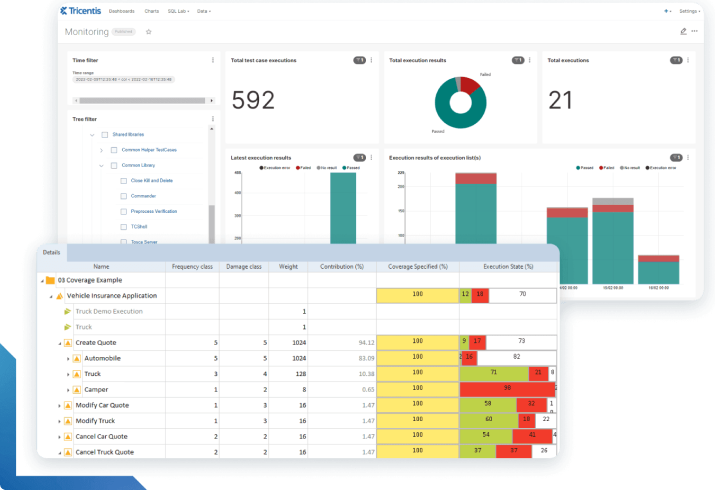
Source: Tricentis Tosca
While Tricentis Tosca offers a robust solution for test automation, it’s important to consider its limitations (sourced from G2):
- Cost: Tosca comes at a high price compared to some competing solutions.
- Compatibility: Tosca does not support macOS or Linux devices, limiting its applicability across different operating environments.
- Learning curve: New users may face a steep learning curve, and the tool’s support for emerging technologies is limited, which could hinder testing of cutting-edge applications.
- Cross-environment testing: The lack of platform independence complicates cross-environment testing.
- Performance: Tosca can be resource-intensive, potentially impacting system performance during test execution.
3. Parasoft

Parasoft offers a suite of solutions that aim to accelerate the testing process, helping teams detect and remediate defects as early as possible in the software lifecycle.
Key features include:
- AI-enhanced static analysis: Parasoft enhances static analysis workflows with AI and ML, streamlining code compliance and accelerating the remediation of findings. This approach aims to reduce the noise often associated with static analysis tools.
- Increased unit testing coverage: Leveraging AI, Parasoft automates the creation of unit tests, significantly reducing the effort required to achieve high code coverage.
- Improved API testing: By utilizing AI, Parasoft simplifies the creation of effective API test scenarios. It can generate tests from manual actions, recorded traffic, or service definitions.
- Smarter Selenium testing: Machine learning is applied to optimize Selenium test maintenance. Parasoft’s solution automatically adjusts tests in response to UI changes, reducing the time and effort required for test maintenance.
- Optimized regression testing: Test impact analysis (TIA) is used to identify the tests affected by code changes, enabling faster feedback and more efficient testing cycles.
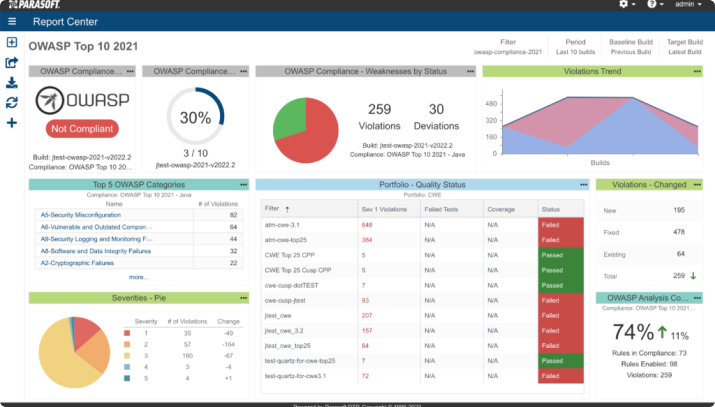
Source: Parasoft
Despite its robust features, users have noted several shortcomings of the solution (sourced from G2):
- Learning curve and usability: Some aspects of the tool could be more intuitive and user-friendly, especially for new users.
- Documentation: The documentation can sometimes be challenging to navigate, with feedback suggesting it should be more accessible to varying levels of expertise.
- Complex setup: Setting up and executing certain types of tests, such as MQ-based web services, can be cumbersome.
- Performance: Users have noted the tool could be resource-intensive, particularly when performing browser testing.
- Integration and debugging: Integrating with third-party tools and debugging, especially when using extension tools with Java, can be problematic. Users have to switch between environments, such as Parasoft and Eclipse IDE, to resolve issues.
4. Testsigma

Testsigma is a test automation platform that leverages Natural Language Processing (NLP) and low-code solutions to create automated tests with minimal maintenance. It emphasizes reliability, and scalability, and aims to make quality engineering accessible to teams regardless of their coding expertise.
Key features include:
- NLP-based test authoring: Testsigma allows the creation of automated tests using plain English, making test authoring accessible to non-technical stakeholders.
- Test recording: In addition to natural language, it is possible to record user actions for test generation.
- Auto-healing tests: The platform’s auto-healing capabilities address the common issue of flaky tests by automatically detecting and adjusting to changes in an application.
- Suggestions engine: When test failures occur, Testsigma’s AI-driven suggestions engine analyzes the failure to identify and suggest the most likely causes.
- Intelligent defect prediction: By predicting potential defects based on test failures, Testsigma helps focus testing efforts on areas most likely to be affected, enhancing test coverage and reducing the risk of regressions.
- Advanced automated testing: Testsigma supports testing across various browser and mobile device environments, either in the cloud or locally, integrating with CI/CD for continuous testing.
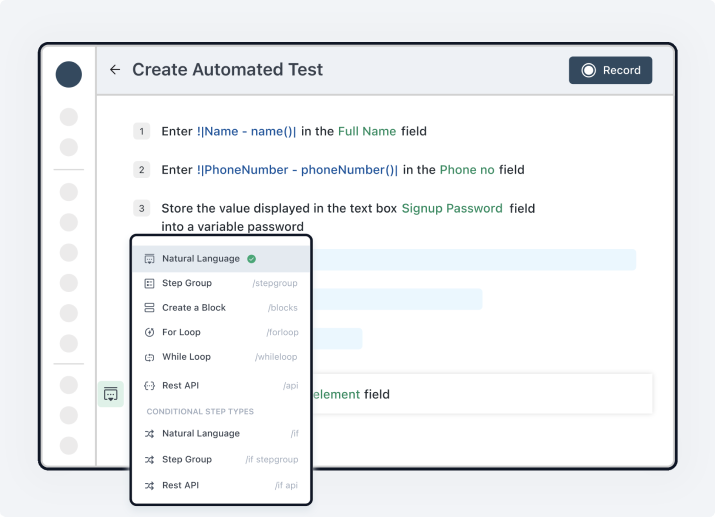
Source: Testsigma
Despite its innovative approach and powerful features, Testsigma users have identified areas for improvement (sourced from G2):
- Reporting capabilities: The reporting feature in Testsigma offers limited functionalities, and could provide more comprehensive insights into testing outcomes.
- Performance issues: Users have reported performance degradation, especially when working with a large number of NLP steps. Performance can slow notably after adding over 200 steps.
- Occasional errors and maintenance impact: Some users encounter unexpected errors, which either resolve spontaneously or require support intervention.
- Execution speed: Test execution speed has been noted as an area for improvement.
5. Katalon Platform

Katalon’s testing platform aims to increase efficiency, provide clear insights, and streamline the test automation process. Making use of AI across its suite, Katalon helps teams write tests faster and improve quality in complex software environments.
Key features include:
- StudioAssist: Accelerates test creation by generating Groovy code and custom Katalon Studio keywords from natural language prompts.
- Explain Code: Automatically generates code commentary.
- TrueTest: Autonomously monitors user journeys in web applications to generate comprehensive, automated test cases.
- Virtual data analyst: Automatically analyzes TestOps data to produce actionable insights, offering a high-level overview of project testing quality.
- Visual testing: Leveraging AI comparison methods, Katalon reduces the effort needed to identify visual regressions, with alerts for UI mismatches.
- Manual test generation: Simplifies the creation of manual test steps from case descriptions, minimizing time spent on interpreting requirements.
- API anomaly detection: The platform identifies APIs exhibiting abnormal performance, aiding in the early detection and correction of potential issues.
- Self-healing: Katalon detects broken locators and suggests working alternatives, reducing the manual effort required for test maintenance.
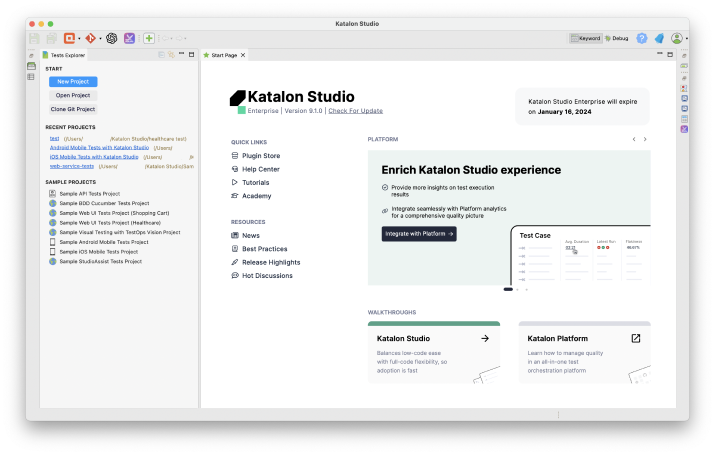
Source: Katalon
While Katalon provides a comprehensive and AI-enhanced testing solution, users have reported some limitations (sourced from G2):
- Learning curve: New users may find the Studio and TestOps platforms overwhelming at first, requiring a period of adaptation and learning to fully leverage its capabilities.
- Licensing costs: Access to certain advanced features such as CI/CD integration, visual testing, and unlimited analytical results in TestOps requires a paid license.
- Mobile execution issues: Users have reported occasional issues with mobile device executions where sessions unexpectedly close, leading to automation failures.
- Hardware resource usage: The platform can be resource-intensive, particularly on machines with limited hardware specifications, affecting performance.
- Compatibility with legacy systems: There are challenges in automating testing for older Java-based systems.
Conclusion
In conclusion, the integration of AI into software testing marks a significant evolution in the field. By automating tasks such as script generation, unit test creation, and code documentation, AI technology not only saves time and resources but also enhances the overall quality and reliability of software products.
The adoption of AI in software testing supports broader development methodologies, such as DevOps, by facilitating continuous testing and rapid feedback loops. As we look to the future, it’s clear that AI will continue to play a central role in shaping the practices and principles of software testing, driving innovation and excellence in software development.
Try Tabnine for free today or contact us to learn how we can help accelerate your software development.



